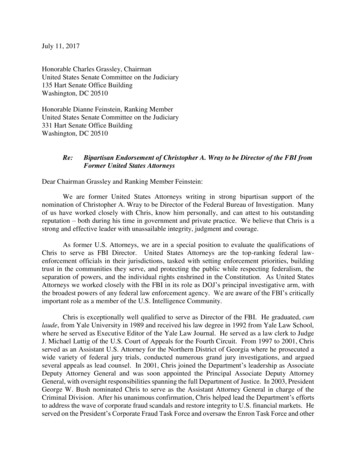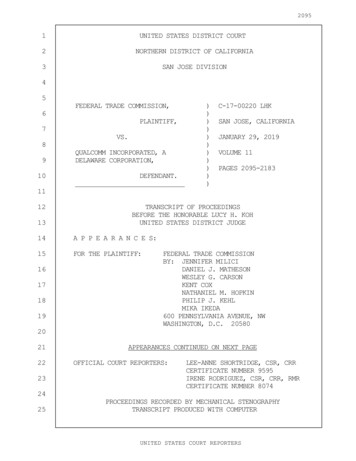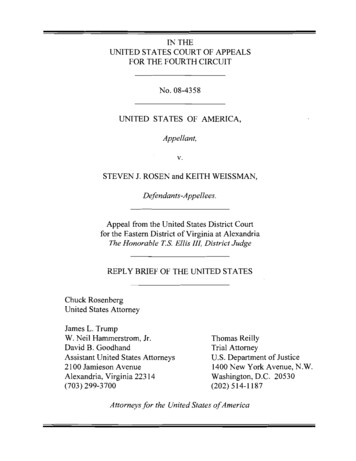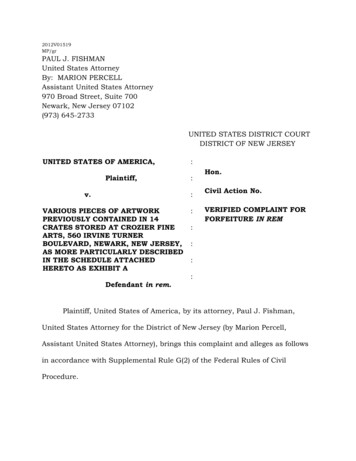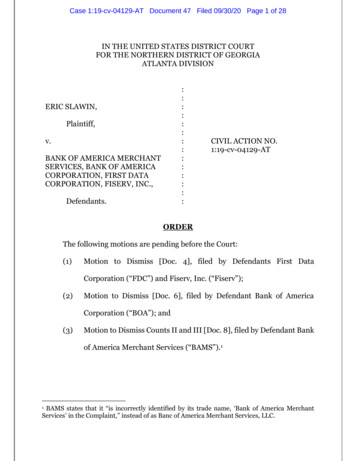
Transcription
Case 1:19-cv-04129-AT Document 47 Filed 09/30/20 Page 1 of 28IN THE UNITED STATES DISTRICT COURTFOR THE NORTHERN DISTRICT OF GEORGIAATLANTA DIVISION::::::::::::::ERIC SLAWIN,Plaintiff,v.BANK OF AMERICA MERCHANTSERVICES, BANK OF AMERICACORPORATION, FIRST DATACORPORATION, FISERV, INC.,Defendants.CIVIL ACTION NO.1:19-cv-04129-ATORDERThe following motions are pending before the Court:(1)Motion to Dismiss [Doc. 4], filed by Defendants First DataCorporation (“FDC”) and Fiserv, Inc. (“Fiserv”);(2)Motion to Dismiss [Doc. 6], filed by Defendant Bank of AmericaCorporation (“BOA”); and(3)Motion to Dismiss Counts II and III [Doc. 8], filed by Defendant Bankof America Merchant Services (“BAMS”).1BAMS states that it “is incorrectly identified by its trade name, ‘Bank of America MerchantServices’ in the Complaint,” instead of as Banc of America Merchant Services, LLC.1
Case 1:19-cv-04129-AT Document 47 Filed 09/30/20 Page 2 of 28Background2This is a whistleblower case, brought under the Sarbanes-Oxley Act of 2002,18 U.S.C. § 1514A, the Consumer Financial Protection Act of 2010, 12 U.S.C. § 5567and the Dodd-Frank Wall Street Reform and Consumer Protection Act, 15 U.S.C.§ 78u-6. Plaintiff Eric Slawin accuses his former employer BAMS, a companywhich provided payment processing services to companies such as Home Depot,Target, Amazon, ExxonMobile, Royal Caribbean Lines, MGM and others, as wellas to municipalities, of failing to handle consumers’ Primary Account Number, or“PAN,” data, in compliance with of Payment Card Industry, or “PCI” standards.(Compl. ¶ 1, 25.) Mr. Slawin alleges that BAMS knowingly misled its customers intobelieving its handling of PAN data met PCI standards, and that he was fired afterraising concerns regarding these deceptive practices with his superiors. (Id. ¶ 1.)Mr. Slawin was formerly a Vice President and Operations Control Officer atBAMS whose job was “to evaluate and assess compliance issues at BAMS, evaluateand assess risk for BAMS, and to develop and propose measures to mitigateidentified risks.” (Compl. ¶ 1.) BAMS was a joint venture between FDC (which isnow a wholly-owned subsidiary of Fiserv)3 and BOA. (Id. ¶¶ 1, 8.)4 Both Fiserv andThe court provides this statement of facts for background, taking well-pleaded allegations in thecomplaint as true and construing them in the light most favorable to the plaintiff. See Hill v.White, 321 F.3d 1334, 1335 (11th Cir. 2003).3 Fiserv entered into a merger agreement to acquire FDC in an all-stock transaction in January of2019. (Compl. ¶ 11.) At all times relevant to the Complaint, FDC was a publicly traded company.Id. ¶ 9.)4 It appears that the joint venture ended in June 2020. Patrick Thomas, Bank of America, FirstData End Payments Partnership, Wall St. J. (July 29, 2019), -data-end-payments-partnership-11564438374 (“Despite the end22
Case 1:19-cv-04129-AT Document 47 Filed 09/30/20 Page 3 of 28BOA are publicly-traded companies. (Id. ¶¶ 10, 14.) BAMS, together with its parent,BOA, enters into agreements to provide payment processing services to itsmerchant customers. (Id. ¶¶ 25–27.) Under these “Merchant ProcessingAgreements,” BAMS and “BOA through its affiliate, Bank of America, N.A. are retailmerchantsandmunicipalities, processing services regarding credit, debit and other delineatedcard transactions and service.” (Id. ¶ 28.) “BAMS and BOA warrant under theseMerchant Processing Agreements that they are operating in compliance with ‘CardOrganization Rules’ which agreements specifically state includes rulespromulgated by the Payment Card Industry Security Standards Council.” (Id. ¶30.)BAMS was the “face” of the business, and handled sales and leasing of pointof-sale equipment to merchants, as wells customer service, while FDC processedthe transactions in the back end. (Id. ¶¶ 34–35.) FDC was PCI compliant. (Id. ¶ 37.)However, BAMS was not (Id. ¶ 47.) This was not an issue for typical credit or debitcard transactions, as these were handled by FDC through FDC terminals. (Id. ¶ 36.)However, BAMS was the point of contact for refunds and chargebacks, whichrequired it to obtain, utilize, store, and convey PAN data. (Id. ¶ 38–39.)Mr. Slawin contends that on or around May 2017, BAMS executives werediscussing the issue of BAMS being non-PCI complaint with respect to PAN data.of the partnership, Bank of America and First Data agreed for products and services to continuebeing provided for Banc of America Merchant Services clients through at least June 2023 . . . .”).3
Case 1:19-cv-04129-AT Document 47 Filed 09/30/20 Page 4 of 28(Id. ¶ 48.) He contends that these discussions also “reflect the decision amongBAMS’ management that it was too costly for BAMS to become PCI complaint, andtherefore that it would not become PCI compliant.” (Id. ¶ 52.) Mr. Slawin raisedconcerns about how BAMS would respond to inquiries by potential and existingcustomers. (Id. ¶ 64.) He repeatedly expressed his concern that BAMS “wasengaging in fraud by not disclosing its non-PCI compliance, instead misleading itspotential and existing customers into believing that it was PCI compliant by havingFirst Data (which was PCI compliant) answer those questions.” (Id. ¶ 66.)“Mr. Slawin was particularly concerned about BAMS’ PCI noncompliancebecause of the seriousness of data security and risk to BAMS’ customers’ and theircustomers in light of such risk,” which included “BAMS’ exposure to large fines.”(Id. ¶ 94.) Aside from that exposure, the purported fraud regarding PCI compliance“implicated mail and wire fraud issues,” as BAMS advertised its PCI compliance aspart of its customer solicitation efforts (Id.) In addition, Mr. Slawin was concernedabout SEC fraud as well as fraud upon shareholders because FDC and BOAincluded BAMS’ financial information in their SEC reports. (Id.)In July of 2017, Mr. Slawin began downloading emails to his personal emailaccount regarding the BAMS’ PCI non-compliance issue out of “concern[] aboutbeing drawn into fraudulent and improper data security practices” as well as “hisintent to go to the SEC.” (Id. ¶ 100.) On December 8, 2017, Mr. Slawin wasapproached by HR concerning these emails, and was asked to destroy the emails4
Case 1:19-cv-04129-AT Document 47 Filed 09/30/20 Page 5 of 28and certify that he had done so. He refused on December 11, and was terminatedon December 12, 2017. (Id. ¶¶ 104, 105.)The same day, December 12, 2017, he electronically filed a whistleblowercomplaint with the SEC. (Id. ¶ 106.) He also filed a whistleblower complaint withOSHA, later amending that complaint on April 27, 2018. (Id. ¶¶ 3, 4.) The Secretaryof Labor had not taken any action after more than 180 following his amendedcomplaint, and OSHA administratively closed its file to allow Mr. Slawin to bringthis action. (Id. ¶ 5.)Legal StandardThis Court may dismiss a pleading for “failure to state a claim upon whichrelief can be granted.” Fed. R. Civ. P. 12(b)(6). A pleading fails to state a claimif it does not contain allegations that support recovery under any recognizable legaltheory. 5 Charles Alan Wright & Arthur R. Miller, Federal Practice & Procedure§ 1216 (3d ed. 2002); see also Ashcroft v. Iqbal, 556 U.S. 662, 678 (2009).Generally, notice pleading is all that is required for a valid complaint. SeeLombard's, Inc. v. Prince Mfg., Inc., 753 F.2d 974, 975 (11th Cir.1985), cert.denied, 474 U.S. 1082 (1986). Under notice pleading, the plaintiff need only givethe defendant fair notice of the plaintiff's claim and the grounds upon which itrests. See Erickson v. Pardus, 551 U.S. 89, 93 (2007) (citing Bell Atlantic v.Twombly, 550 U.S. 544, 555 (2007)). In ruling on a motion to dismiss, the courtmust accept the facts pleaded in the complaint as true and construe them in thelight most favorable to the plaintiff. See Hill v. White, 321 F.3d 1334, 1335 (11th5
Case 1:19-cv-04129-AT Document 47 Filed 09/30/20 Page 6 of 28Cir. 2003); see also Sanjuan v. American Bd. of Psychiatry and Neurology, Inc.,40 F.3d 247, 251 (7th Cir. 1994) (noting that at the pleading stage, the plaintiff“receives the benefit of imagination”).A complaint should be dismissed under Rule 12(b)(6) only where it appearsthat the facts alleged fail to state a “plausible” claim for relief. Bell Atlantic v.Twombly, 550 U.S. 544, 555-556 (2007); Fed. R. Civ. P. 12(b)(6). A complaint maysurvive a motion to dismiss for failure to state a claim, however, even if it is“improbable” that a plaintiff would be able to prove those facts and even if thepossibility of recovery is extremely “remote and unlikely.” Twombly, 550 U.S. at556 (citations and quotations omitted). A claim is plausible where the plaintiffalleges factual content that “allows the court to draw the reasonable inference thatthe defendant is liable for the misconduct alleged.” Ashcroft v. Iqbal, 556 U.S. at678. The plausibility standard requires that a plaintiff allege sufficient facts “toraise a reasonable expectation that discovery will reveal evidence” that supportsthe plaintiff’s claim. Twombly, 550 U.S. at 556. A Plaintiff is not required toprovide “detailed factual allegations” to survive dismissal, but the “obligation toprovide the ‘grounds’ of his ‘entitle[ment] to relief’ requires more than labels andconclusions, and a formulaic recitation of the elements of a cause of action will notdo.” Id. at 555.DiscussionPlaintiff raises whistleblower retaliation claims under Sarbanes-Oxley Act,18 U.S.C. § 1514A (“SOX”) (Count I), the Consumer Financial Protection Act,6
Case 1:19-cv-04129-AT Document 47 Filed 09/30/20 Page 7 of 2812 U.S.C. § 5567 (“CFPA”) (Count II), and Section 922(a) of the Dodd-Frank WallStreet Reform and Consumer Protection Act, 15 U.S.C. § 78u-6 (“DoddFrank”) (Count III). BAMS seeks dismissal of Counts II and II against it, whileBOA, FDC, and Fiserv each seek dismissal of all three Counts against them.The elements of a prima facie case under each of the statutes are similar. “Toassert a whistleblower claim under SOX, the Plaintiff ‘must show by apreponderance of the evidence that (1)[he] engaged in protected activity; (2) theemployer knew of the protected activity; (3)[he] suffered an unfavorable personnelaction; and (4) circumstances exist to suggest that the protected activity was acontributing factor to the unfavorable action.’” Bozeman v. Per-Se Techs., Inc., 456F. Supp. 2d 1282, 1358 (N.D. Ga. 2006) (quoting Collins v. Beazer Homes USA,Inc., 334 F. Supp.2d 1365, 1375 (N.D. Ga.2004)) (alterations in original).Likewise, to state a claim for retaliation under the CFPA, 12 U.S.C. § 5567, aplaintiff must establish “that (1) he engaged in protected activity; (2) the employerknew or suspected, either actually or constructively, that he engaged in theprotected activity; (3) he suffered an unfavorable personnel or employment action;and (4) the protected activity was a contributing factor in the unfavorable action.”Veard v. F&M Bank, 704 F. App’x 469, 473 (6th Cir. 2017) (internal quotationmarks omitted).Finally, “[t]o plead a valid claim for retaliation under Dodd-Frank, Plaintiffmust allege that: (1) he engaged in protected activity; (2) he suffered a materiallyadverse employment action; and (3) there was a causal connection between the7
Case 1:19-cv-04129-AT Document 47 Filed 09/30/20 Page 8 of 28adverse action and the protected activity.” Grimm v. Best Buy Co., No. 16-1258,2017 WL 9274874, at *4 (D. Minn. Apr. 19, 2017), report and recommendationadopted, No. 16-1258, 2017 WL 2345585 (D. Minn. May 30, 2017); see alsoMartensen v. Chicago Stock Exchange, 882 F.3d 744, 746 (7th Cir. 2018).Defendants’ arguments for dismissal can be lumped into the followingcategories: (1) failure to exhaust remedies under SOX or CFPA,5 (2) failure to makea report to the SEC prior to his termination under Dodd-Frank,6 (3) failure to allegethat the non-BAMS Defendants employed Mr. Slawin,7 (4) failure to show thatnon-BAMS Defendants knew of any protected conduct or took an adverseemployment action,8 (5) failure to allege that Defendants are covered persons orservice providers under the CFPA or that Mr. Slawin engaged in protected activityunder that Act,9 and (6) as to the non-BAMS defendants, failure to demonstratevicarious or successor liability.10Exhaustion of Administrative Remedies (SOX and CFPA)First, BOA contains that Mr. Slawin did not exhaust his administrativeremedies against the non-BAMS parties, because he failed to name them as(See Def. BOA’s Br. Supp’t Mot. to Dismiss at 4 (“BOA Br.”), Doc. 6-1.) BOA also argues, for thefirst time in its Reply Brief, that Mr. Slawin does not allege that fraud was committed by a publiccompany as required by SOX. Def. BOA’s Reply Br. at 6 (“BOA Reply”), Doc. 35.) This argumentwas not raised in BOA’s opening brief or any of the opening briefs of the other Defendants, and istherefore waived.6 (See BOA Br. at 11; Def. BAMS’s Br. Supp’t Mot to Dismiss at 14 (“BAMS Br.”), Doc. 8; Defs.’FDC and Fiserv’s Br. Supp’t Mot. to Dismiss at 10 (“Fiserv Br.”), Doc. 4.)7 (See BOA Br. at 7; Fiserv Br. at 5.)8 (See BOA Br. at 9; Fiserv Br. at 7.)9 (See BAMS Br. at 5, 11; Fiserv Br. at 6; see also Defs. FDC and Fiserv’s Reply Br. at 10 (“FiservReply”), Doc. 34; BOA Reply at 13)10 (See Fiserv Br. at 12; BOA Reply at 4, 7, 8, 10.)58
Case 1:19-cv-04129-AT Document 47 Filed 09/30/20 Page 9 of 28respondents in the caption of his administrative complaint. 11 Both the CFPA andSOX contain procedures for submitting whistleblower complaints to the Secretaryof Labor (through OSHA) prior to bringing civil actions in district court.1.Statutory Background andAdministrative HistorySection 1514A of SOX provides the following:(b) Enforcement Action.-(1) In general.--A person who alleges discharge or otherdiscrimination by any person in violation of subsection (a) mayseek relief under subsection (c), by-(A) filing a complaint with the Secretary of Labor; or(B) if the Secretary has not issued a final decision within180 days of the filing of the complaint and there is noshowing that such delay is due to the bad faith of theclaimant, bringing an action at law or equity for de novoreview in the appropriate district court of the UnitedStates, which shall have jurisdiction over such an actionwithout regard to the amount in controversy.This provision has been held to impose an administrative exhaustion requirement.Digital Realty Tr., Inc. v. Somers, 138 S. Ct. 767, 773 (2018) (“To recover under§ 1514A, an aggrieved employee must exhaust administrative remedies by ‘filing acomplaint with the Secretary of Labor.’”); see also Bozeman, 456 F. Supp. 2d atThe OSHA Amended Complaint is attached to BOA’s Motion to Dismiss as Exhibit 1. (Doc. 62.) The Court may consider this attachment on a motion to dismiss because it was referenced inthe Complaint and because exhaustion by filing the OSHA Amended Complaint is central toseveral of Plaintiff’s claims. (E.g., Compl. ¶ 3–6.) Brooks v. Blue Cross and Blue Shield of Florida,Inc., 116 F.3d 1364 (11th Cir. 1997) (“[W]here the plaintiff refers to certain documents in thecomplaint and those documents are central to the plaintiff’s claim, then the Court may considerthe documents part of the pleadings for purposes of Rule 12(b)(6) dismissal, and the defendant’sattaching such documents to the motion to dismiss will not require conversion of the motion intoa motion for summary judgment.”).119
Case 1:19-cv-04129-AT Document 47 Filed 09/30/20 Page 10 of 281357 (“A federal court ‘can only conduct a de novo review of those [SOXwhistleblower] claims that have been administratively exhausted.’”) (quotingWillis v. Vie Financial Group, Inc., No. 04-435, 2004 WL 1774575, at *6 (E.D. Pa.Aug. 6, 2004).Similarly, the CFPA provides thata person who believes that he or she has been discharged or otherwisediscriminated against by any person in violation of subsection (a)may, not later than 180 days after the date on which such allegedviolation occurs, file (or have any person file on his or her behalf) acomplaint with the Secretary of Labor alleging such discharge ordiscrimination and identifying the person responsible for such act.12 U.S.C. § 5567(c)(1)(A). Then,[i]f the Secretary of Labor has not issued a final order within 210 daysafter the date of filing of a complaint under this subsection, or within90 days after the date of receipt of a written determination, thecomplainant may bring an action at law or equity for de novo reviewin the appropriate district court of the United States havingjurisdiction.12 U.S.C. § 5567(c)(4)(D). While few courts have addressed whether this statuteposes a jurisdictional administrative exhaustion requirement, Mr. Slawin does notcontest that the CFPA, like SOX, contains an administrative exhaustionrequirement, but instead contends that he has exhausted all of his administrativeremedies as to BOA.Mr. Slawin’s OSHA Amended Complaint names Bank of America MerchantServices, LLC, as well as several individuals as respondents. (Doc. 6-2.) (“OSHAComplaint”) Page 3 of the OSHA Complaint states that:Respondent BAMS was established in 2009 as a Joint venturebetween Bank of America (“BOA”) and First Data Corporation (“First10
Case 1:19-cv-04129-AT Document 47 Filed 09/30/20 Page 11 of 28Data”) to provide payment processing services. BOA and First Datahive roughly equivalent ownership stakes in BAMS, with a third partyinvestor owning a very small stake. BAMS is a subsidiary of First DataCorporation and is listed as such on First Data’s SEC filings, includingits most recent 10K filed with the SEC on February 21, 2018. First DataCorporation is a publicly traded company, BAMS is also denominatedas an affiliate of BOA and included in BOA’s financial reports filedwith the SEC. BOA is a publicly traded company.(Id. at 3.) Page 9 of the OSHA Complaint states thatMr. Slawin was concerned about SEC fraud as well as fraud uponshareholders, as a result of BAMS’ financial status inclusion in BAMS’parent company, First Data’s reports filed with the SEC, as well asBOA’s financial statements filed with the SEC in which BAM’s [sic]results were included on a consolidated basis.(Id. at 9.) The Secretary of Labor did not issue a final decision within 210 days ofhis OSHA Complaint, and thereafter Mr. Slawin brought this action. 12 U.S.C. §5567(c)(4)(D); 18 U.S.C. § 1514A(b)(2)(D).2.Analysis of Exhaustion IssueBOA contends that the reference to it in the OSHA Complaint as BAMS’sparent is insufficient to exhaust remedies as to it.12 It points to OSHA’s SOXregulations which define “respondent” in as “the person named in the complaintwho is alleged to have violated the Act,” and which require that the complainantallege the respondent’s knowledge and that OSHA provide notice to therespondent. 29 C.F.R. §§ 1980.101(k), 1980.104(a), (b), (e), (f).Fiserv and FDC, in footnote 3 of their Reply brief, incorporate by reference any argument madeby any other Defendant, which “for consistency would require dismissal of the Complaint.”(Fiserv Reply at 15 n. 3.)1211
Case 1:19-cv-04129-AT Document 47 Filed 09/30/20 Page 12 of 28It also cites to two cases from this circuit. First, BOA cites to a decision byJudge Vining in this district which held that, in the SOX context “the mere fact that[a defendant] is mentioned in the body of the OSHA complaint is insufficient” toexhaust administrative remedies. Bozeman v. Per-Se Techs., Inc., 456 F. Supp. 2d1282, 1358 (N.D. Ga. .,No.3:08CV3/MCR/EMT, 2009 WL 903624, at *8 (N.D. Fla. Mar. 31, 2009), whichfound no exhaustion as to defendants who were not named “in the heading of[plaintiff’s] administrative complaint or indeed anywhere in her complaint.” TheEleventh Circuit affirmed in an unpublished decision, writing in a footnote that“Even if [plaintiff] had engaged in protected conduct, the district court was correctin dismissing her claim on the basis that Smith failed to exhaust her administrativeremedies with respect to” those defendants. 358 Fed. Appx. 76, 78 (11th Cir. 2009).In response, Mr. Slawin relies on Andrews et al. v. ING North AmericaInsurance Corp., No. 06-071, 2008 WL 4124111 (DOL Adm. Rev. Bd. Aug. 29,2008). In that case, the Department of Labor’s Administrative Review Board heldthat “SOX does not require a complainant to name a corporate respondent that [isitself covered under SOX] . . . so long as the complainant names at least onerespondent who is covered under the Act as an ‘officer, employee, contractor,subcontractor, or agent’ of such a company.” Id. at *3.13SOX was amended in 2010 as part of the Dodd-Frank act to cover, in addition to officers,employees, agents, etc., “any subsidiary or affiliate whose financial information is included in the1312
Case 1:19-cv-04129-AT Document 47 Filed 09/30/20 Page 13 of 28Mr. Slawin also points to a California district court decision which rejectedJudge Vining’s conclusion in Bozeman and held that an opposing party need notbe named as a respondent in an administrative complaint so long as the complaintprovides the party “‘fair notice’ of the charges against it.” Wadler v. Bio-Rad Labs.,Inc., 141 F. Supp. 3d 1005, 1020 (N.D. Cal. 2015) (quoting Evans v. U.S. Envtl.Prot. Agency, 2012 WL 3164358, at *6 (DOL Adm. Rev. Bd., July 31, 2012) andciting Donovan v. Royal Logging Co., 645 F.2d 822, 826 (9th Cir. 1981)).BOA attempts to distinguish Andrews and Wadler by noting that those casesinvolved allegations of wrongdoing by the entity not named as a respondent. (BOAReply at 3–4.) BOA argues that the OSHA Complaint here “did not (1) identify BOAas a respondent, (2) accuse BOA of any violation, or (3) seek any relief from BOA.”(BOA Reply at 2.) It further argues that Mr. Slawin does not allege that BOA hadnotice of his OSHA Complaint. (Id. at 3.)If the Court were writing on a blank slate, it would find a certain appeal tothe functionalist reasoning found in Mr. Slawin’s cited cases. However, the Courtmust grapple with the persuasive effect of the Eleventh Circuit’s Smith decision,which affirmed a district court’s decision finding lack of exhaustion againstdefendants not named as respondents before OSHA. Smith is an unpublisheddecision,14 and the alternative and summary nature of the footnote on pointconsolidated financial statements of such company.” Pub.L. 111-203, § 922(b), (c), 124 Stat. 1848(amending 18 U.S.C. § 1514A).14 See 11th Cir. R. 36-2 (“Unpublished Opinions. An opinion shall be unpublished unless a majorityof the panel decides to publish it. Unpublished opinions are not considered binding precedent,but they may be cited as persuasive authority.”).13
Case 1:19-cv-04129-AT Document 47 Filed 09/30/20 Page 14 of 28renders the exhaustion determination arguably dicta. 358 Fed. Appx. at 78. Evenso, the Court is reluctant to deviate from a clear decision of the Eleventh Circuit,albeit a nonbinding one, absent serious contrary persuasive authority which is notpresent here in light of BOA’s efforts to distinguish Mr. Slawin’s cases.Mr. Slawin argues Smith is itself distinguishable, because unlike that case,BOA was at least mentioned in the OSHA Complaint in this case. Compare 2009WL 903624, at *8 (“In the instant case, Smith did not name PBS or GCTC in theheading of her administrative complaint or indeed anywhere in her complaint.”)(emphasis in original). However, the only references to BOA in the OSHAComplaint appear to be for the purpose of establishing that BAMS is subject to aSOX claim because it is “a subsidiary or affiliate whose financial information isincluded in the consolidated financial statements of” an entity covered by SOX. 18U.S.C. § 1514A. Nowhere in the OSHA Complaint is BOA, or Fiserv for that matter,accused of any retaliatory action. While the Court does not read Smith as adoptinga per se rule requiring naming a SOX defendant as a respondent in anadministrative complaint to exhaust remedies as to that defendant, the fewreferences to BOA and Fiserv in the OSHA Complaint do not materially distinguishthis case from Smith.15 Moreover, while Smith involved SOX, and not the CFPA,Mr. Slawin further argues that Smith is distinguishable because it was decided before the “2010amendment to SOX that clarified that a parent corporation may be liable for the unlawful acts ofits wholly owned subsidiary whose financial statements are incorporated into the consolidatedfinancial statements of the parent corporation.” (Pl.’s Resp. to BOA at 23, Doc. 30.) But the 2010amendments merely clarified that subsidiaries and affiliates could themselves be liable under SOXunder those circumstances. 18 U.S.C.A. § 1514A(a). BAMS, the respondent in the OSHAComplaint, has not moved to dismiss the SOX count on the grounds that it is not covered by SOX.(See generally, BAMS Br.)1514
Case 1:19-cv-04129-AT Document 47 Filed 09/30/20 Page 15 of 28Mr. Slawin does not set forth a reason why a different standard would apply underthe similar statutory language, and as noted above, he concedes that an exhaustionrequirement applies. Consequently, the Court finds that Counts I and II must beDISMISSED as to BOA, Fiserv, and FDC.Timeliness of SEC Complaint (Dodd-Frank)All Defendants move to dismiss Count III on the grounds that Mr. Slawinwas required to bring his Dodd-Frank whistleblower complaint prior to thechallenged adverse employment action under the Supreme Court’s decision inDigital Realty Tr., Inc. v. Somers, 138 S. Ct. 767 (2018). Digital Realty held that aputative whistleblower who “did not provide information ‘to the [Securities andExchange] Commission’ before his termination . . . did not qualify as a‘whistleblower’ at the time of the alleged retaliation” under Dodd-Frank. 138 S. Ct.at 778 (citing 15 U.S.C. § 78u–6(h) (“The term ‘whistleblower’ means anyindividual who provides . . . information relating to a violation of the securities lawsto the Commission, in a manner established, by rule or regulation, by theCommission.”)).Mr. Slawin attempts to distinguish Digital Realty on the grounds that DoddFrank’s definition of “whistleblower” contains no requirement that information beprovided to the SEC before termination, and argues that the plaintiff in DigitalRealty did not file an SEC report at all. (Pl.’s Resp. to BOA Br. at 29–29, 29 n. 19).However, he points to no case law accepting this argument; in contrast, BOA citesthe Fifth Circuit’s contrary decision in Frye v. Anadarko Petroleum Corp., No. 1815
Case 1:19-cv-04129-AT Document 47 Filed 09/30/20 Page 16 of 2820543, 2019 WL 7374806, at *5 (5th Cir. Nov. 4, 2019) and a host of district courtdecisions. (BOA. Br. at 15 n. 5) (collecting cases).While this outcome may seem harsh, the Supreme Court recognized thepossibility that, for example, “lawyers and auditors will face retaliation quickly,before they have a chance to report to the SEC,” but pointed out that there was“nothing to show that Congress had this concern in mind when it enacted § 78u–6(h).” 138 S. Ct. at 780. (“Indeed, Congress may well have considered adequate thesafeguards already afforded by Sarbanes–Oxley, protections specifically designedto shield lawyers, accountants, and similar professionals.”)Because Mr. Slawin was not a whistleblower under 15 U.S.C. § 78u-6(a)(6)at the time of the alleged retaliation, Count III of the Complaint (Dodd-Frank)must be DISMISSED as to all parties.As this fully resolves all claims against the non-BAMS Defendants, the Courtneed not address whether Mr. Slawin failed to allege that non-BAMS Defendantsemployed Mr. Slawin or failed to show that non-BAMS Defendants knew of anyprotected conduct or took an adverse employment action. The Court also need notaddress whether the non-BAMS Defendants are vicariously liable for BAMS’sconduct. Mr. Slawin has implied that BOA may be the successor by dissolution ofBAMS pursuant to Fed. R. Civ. P. 25(c) and the Eleventh Circuit’s decision in Virgov. Riviera Beach Associates, 30 F.3d 1350, 1358 (11th Cir. 1994). The question ofwhether any of the non-BAMS parties is the successor to BAMS under applicablestate law is distinct from the foregoing questions, and this Order is without16
Case 1:19-cv-04129-AT Document 47 Filed 09/30/20 Page 17 of 28prejudice to such arguments. However, Mr. Slawin has not filed a motion tosubstitute under that rule, and until such time, Rule 25 presumes that an action“may be continued by or against the original party.” The Parties should conferabout this matter as part of the scheduling conference and either agree uponsubstitution, or if they cannot, Mr. Slawin is authorized to file a motion under Rule25(c) within 30 days of the date of entry of this Order.16Consumer Financial Protection ActBAMS next argues that Mr. Slawin fails to state a claim for retaliation underthe CFPA because he failed to plausibly allege that BAMS is a covered person orservice provider under that Act or that Mr. Slawin engaged in protected activityunder the Act. The Court first addresses the argument that Mr. Slawin has not pledthat BAMS is covered by the Act, and then the argument that he has not engagedin protected activity.1.Covered Person or Service ProviderThe whistleblower protection statute of the CFPA provides that “[n]ocovered person or service provider shall terminate or in any other way discriminateagainst, or cause to be terminated or discriminated against, any covered employee. . . by reason of the fact that such employee” has engaged in certain protectedactivities, discussed further below. 12 U.S.C. § 5567(a). The first question for theCourt is whether BAMS is a covered person or service provider under the Act.If there is a need for discovery with respect to this issue, the Parties should address it in theirforthcoming Joint Preliminary Report and Discovery Plan.1617
Case 1:19-cv-04129-AT Document 47 Filed 09/30/20 Page 18 of 28Mr. Slawin alleges that:The Defendants are covered service providers employer
Services' in the Complaint," instead of as Banc of America Merchant Services, LLC. Case 1:19-cv-04129-AT Document 47 Filed 09/30/20 Page 1 of 28. 2 Background2 This is a whistleblower case, brought under the Sarbanes-Oxley Act of 2002,





